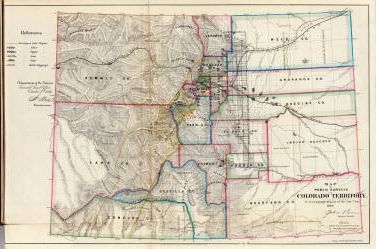Denver is a growing town in the Colorado Territory, far from the battles of the present war. This month the first permanent church in the town takes roots.
Precisely one week ago, Walker McDuffie Potter and his sister Lucy had disembarked in Denver. They arrive in this western town as missionaries appointed by the American Baptist Home Missionary Society to the Colorado Territory. Today, Potter preaches to a gathering of ten persons.
The worship service today is the beginnings of the First Baptist Church of Denver. Formal organization takes place on May 2, 1864, with nine founding members. The first meeting house is constructed on the corner of 16th and Curtis. Initially, due to lack of funding, a cellar and four foot walls are built. Resembling a potato cellar, the structure is commonly referred to by locals as the “Holy Dug-Out.” Rev. Potter, passing away in 1866 at the age of 29, does not live to see the construction of a more permanent structure.
Nontheless, the Potters leave a lasting stamp upon the city. Having acquired 320 Homestead Act acres in what eventually becomes downtown Denver, Potter bequeaths the land to the Missionary Society to be used in paying off church debt incurred by the Society. However, First Baptist Denver also claims ownership of the land. The Society, deeming the land worthless, seeks cash payment from the church. The congregation, however, has no money. Several years of negotiations follow with the American Baptist Home Missionary Society, First Baptist Church Denver, Lucy Potter and a church investor, Samuel Crozer, seeking resolution. Resolving the issues in 1872, the land is sold and the proceeds divided among the various parties. From the land, a 36-acre residential district is platted in the present downtown Denver area between West 32nd and West 38th avenues.
In 1875, the town of Highlands is founded. Its existence, however, proves short lived. The national Silver Crash of 1893 leads Highland’s citizens to annex the town to Denver three years later. In 1979, the Denver Landmark Preservation Commission establishes the Potters-Highlands Historic District in recognition of the contributions of Walker and Lucy Potter.
Meanwhile, Dr. Winfield Scott, the church’s second pastor, leads the First Baptist Denver congregation to construct a complete building at 18th and Curtis. Opening in 1873, the building serves as the church’s home until 1883.
Scott, a decorated Union officer and chaplain during the war, moves to Arizona in 1888 and helps found Scottsdale, Arizona.
The First Baptist Church of Denver thrives in the years following, moving and rebuilding several times. The church is a prominent congregation in present-day Denver.
Sources: Wilbur Fiske Stone, History of Colorado, Vol. 1, Chicago: S. J. Clarke, 1918, pp. 636-637 (link); National Register of Historic Places Registration Form, First Baptist Church of Denver (link); “Potter-Highlands Historic District,” Denver Public Library (link); Winfield Scott Exhibit, Scottsdale Historical Society (link)



